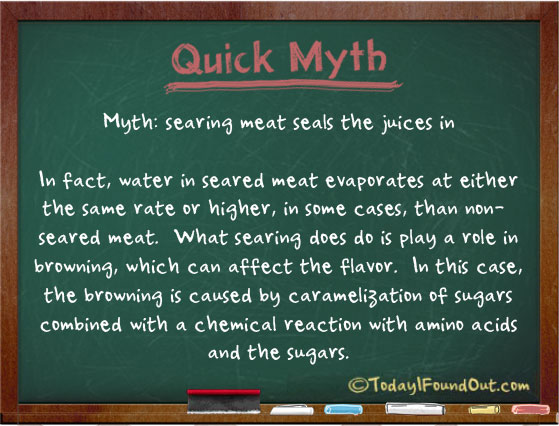Searing Meat Does Not “Seal in the Juices”
Myth: Searing meat seals the juices in. In fact, water in seared meat evaporates at either the same rate or higher, in some cases, than non-seared meat. What searing does do is play a role in browning, which can affect the flavor. But, in this case, the browning is caused by caramelization of sugars combined with a chemical reaction with amino acids and the sugars.
| Share the Knowledge! |
|






Please cite and research your sources better. The only evidence cited for this “fact” is hidden in a wikipedia page, a single source whose book was quoted from one page, meaning that we cannot check the evidence without buying his book. I’m assuming you did not read the actual evidence, and presented it as a fact anyway.
In reality, there is debate over the effect of searing meat prior to further cooking. Some people think it seals in juice, some don’t.
@CStanley: “I’m assuming you did not read the actual evidence, and presented it as a fact anyway” I understand your skepticism as most “fact” sites out there are filled with false facts, demonstrating the author’s lack of caring about being factual and being more about just creating a new post for search engines and people to look at who most of which won’t bother to look into things for themselves. However, I started this site to provide a place where people could go and know what they are reading is actually true, at least as far as we know from the current state of human knowledge. It takes a lot longer on my part to research things, but I enjoy research and I do this for a living, so I take it very seriously. I won’t say I’ve never been wrong on this site, but it doesn’t happen often and you’d be hard pressed to find a more accurate fact site on the internet.
“a single source whose book was quoted from one page, meaning that we cannot check the evidence without buying his book.” That’s how book references work… In truth, I tend to avoid book references for this very reason, as it’s not very convenient for you to look it up. You kind of have to read the book, or I suppose I could just violate his copyright and publish it directly here… In this instance, as it’s not part of the main article, just in the comments; I *think* it’s not technically a copyright violation because I’ll keep the snippet as short as possible, not quoting the whole thing; and as way of proving that I not only own the book (well the updated version from what is cited on Wikipedia; it really is a phenomenal book if you want to know about the science behind cooking: On Food and Cooking: The Science and Lore of the Kitchen), but have also read it (at least the parts concerning searing, I haven’t actually read the entire book, it’s over 800 pages and I’m not that interested in cooking) ;-), here it is:
And as to why this myth is so persistent:
Now, if you could find a scientifically done study on searing vs. juice retention that shows it actually really does “seal in the juices” somehow, despite that browned meat isn’t waterproof and the fact that water loss in meat is directly proportional to the temperature it’s cooked at, I’d be happy to revisit this and possibly remove the quick myth, but I couldn’t find one, only subjective data, and I searched for quite some time. What I did find that wasn’t subjective was that numerous such experiments have been performed (easy enough to do yourself even with a simple kitchen scale) and in every single case the seared meat had the same or less moisture than the non-seared meat.
What I did find that wasn’t subjective was that numerous such experiments have been performed (easy enough to do yourself even with a simple kitchen scale) and in every single case the seared meat had the same or less moisture than the non-seared meat.
Taking the EdX class on Science and cooking and our friend here is absolutely correct. Searing DOES NOT lock in juices, it only browns the meat. If my readings are correct, Julia Child’s acknowledged this motion but, ultimately threw it out the proverbial cooking window